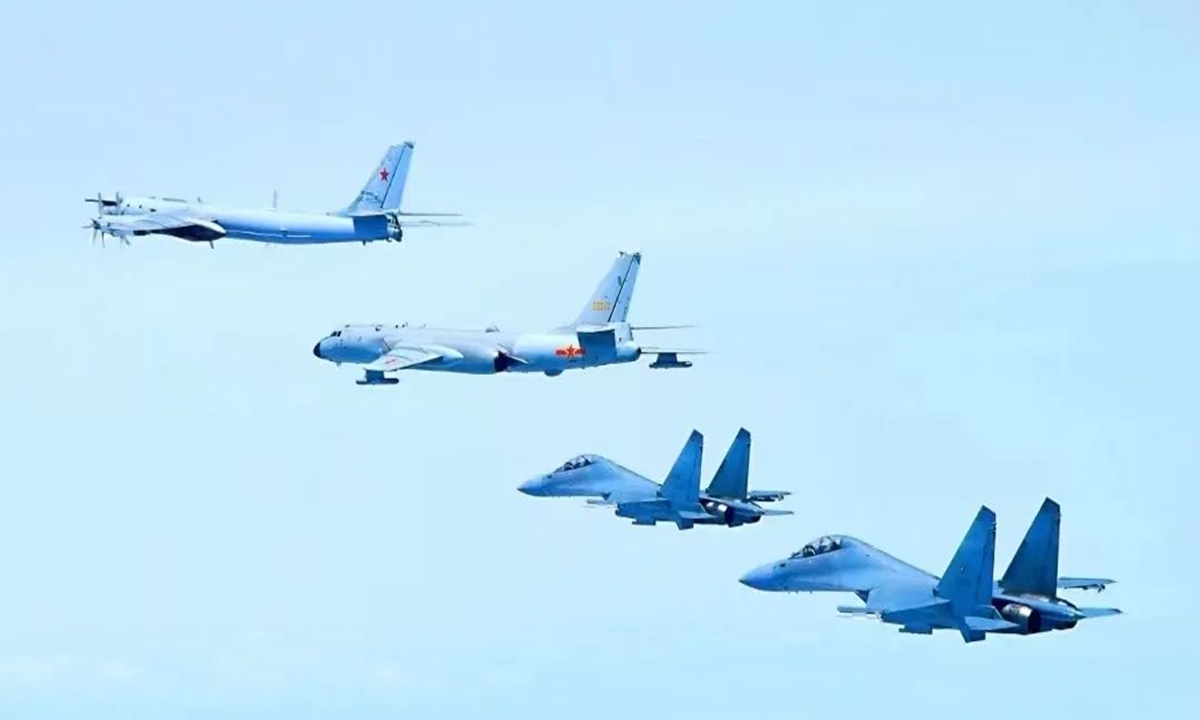
Two Chinese J-16 fighter jets conduct an escort mission for a Chinese H-6K bomber and a Russian Tu-95MS bomber during a regular China-Russia joint strategic patrol above the Sea of Japan, the East China Sea and the West Pacific on May 24, 2022. Photo: Screenshot from China Central Television
The Chinese and Russian militaries on Thursday held their second joint aerial strategic patrol of the year, the seventh in total since 2019, reportedly adding electronic warfare and reconnaissance aircraft to a group of bombers and fighters, in a move experts said was aimed at safeguarding peace and stability in the region.
In accordance with an annual cooperation plan between the Chinese and Russian militaries, the two sides organized and carried out the seventh joint aerial strategic patrol over the Sea of Japan and the East China Sea on Thursday, China's Ministry of National Defense said in a press release on Thursday.
Earlier on Thursday, South Korea's Joint Chiefs of Staff said that two Chinese and four Russian aircraft entered South Korea's air defense identification zone in the Sea of Japan and exited it without violating South Korea's air space on the day, Yonhap News Agency reported.
The Chinese military aircraft were carrying out routine and conventional flight activities in international air space in compliance with international law, said Mao Ning, a spokesperson at China's Ministry of Foreign Affairs, at a regular press conference on Thursday.
Japan's Ministry of Defense Joint Staff said in a press release later on Thursday that Japan on the day spotted two Chinese H-6 bombers entering the Sea of Japan from the East China Sea. They rendezvoused with two Russian Tu-95 bombers there, then conducted long-range joint flight operation toward the East China Sea.
During various stages of the joint flight, the Chinese and Russian bombers were accompanied by other types of aircraft, including J-16 fighter jets and a Y-8 electronic countermeasure aircraft plus fighter jets of unidentified types from the Chinese side, and Su-35 fighter jets and a Tu-142 patrol aircraft plus fighter jets of unidentified types from the Russian side, the Japanese press release said.
The latest China-Russia joint aerial strategic patrol is a clear signal that such joint patrols have become routine, and they serve a clear goal, which is to safeguard peace and stability in the region, Song Zhongping, a Chinese military expert and TV commentator, told the Global Times on Thursday.
In addition to familiar faces in previous joint patrols like H-6 and Tu-95 bombers as well as their escorting fighter jets, this time China added the Y-8 electronic countermeasure aircraft and Russia sent the Tu-142 patrol aircraft to the joint patrol, Song noted.
Song said that these aircraft can provide reconnaissance and target guidance for the bombers to carry out long-range strikes, forming tactical coordination as well as strategic deterrence.
In what analysts said could be a sea-air integration operation in the China-Russia joint aerial strategic patrol, a Type 055 large destroyer of the PLA Navy entered the Sea of Japan through the Tsushima Strait from the East China Sea from Monday to Tuesday, according to a press release by Japan's Ministry of Defense Joint Staff on Tuesday. The Chinese warship likely remained operating in the Sea of Japan on Thursday when the Chinese and Russian aircraft patrolled the region, observers said.
China and Russia have been holding regular joint aerial strategic patrols since 2019.
The latest joint patrol is the second of its kind held in 2023. The first edition of the year was held in June, when Chinese and Russian warplanes covered the Sea of Japan, the South China Sea and the West Pacific in a two-day operation.




